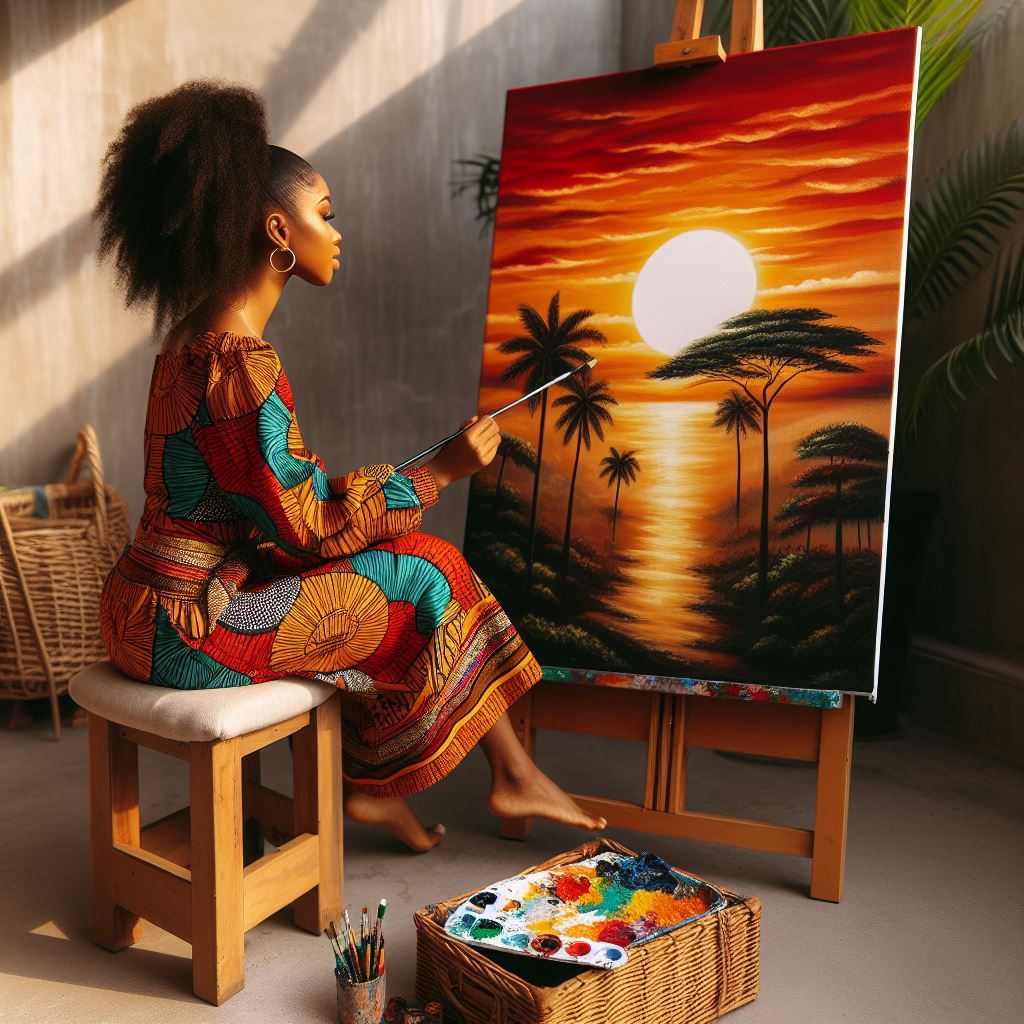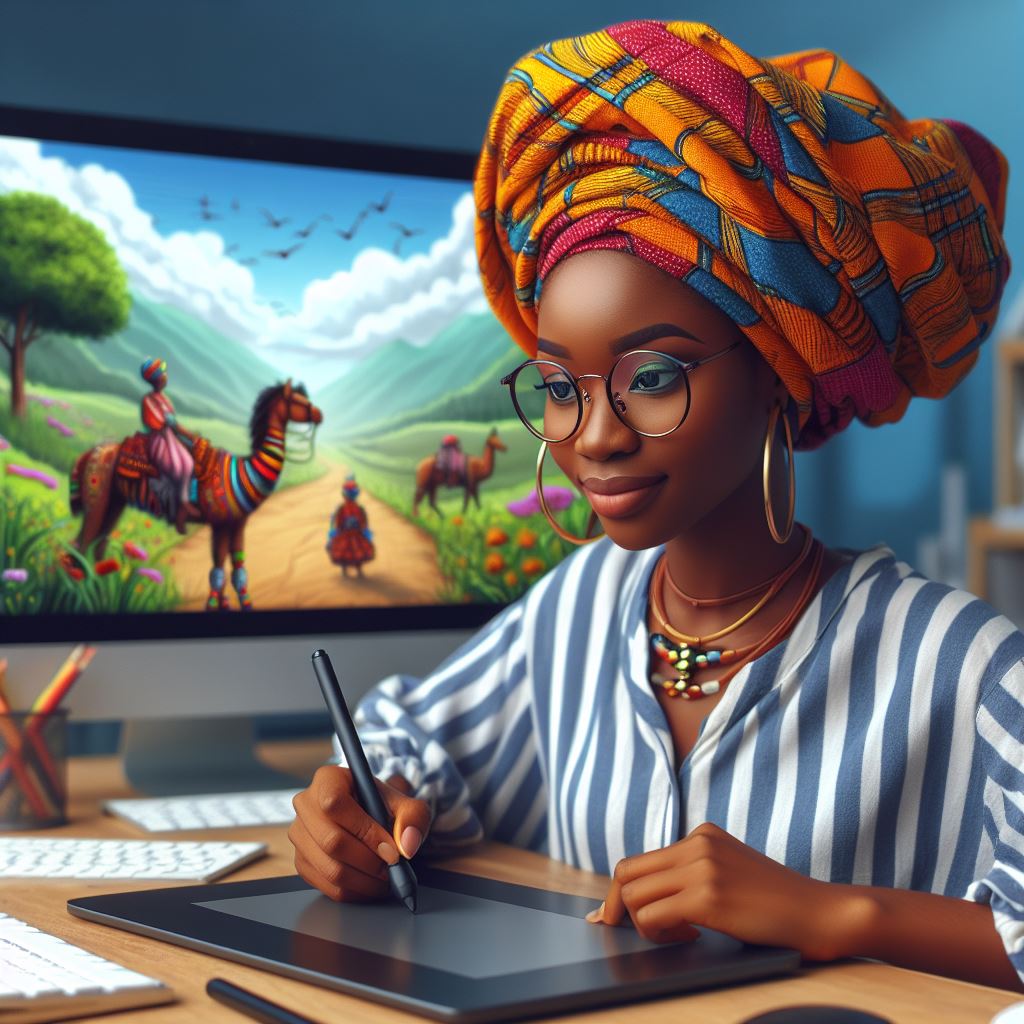Introduction
Art criticism, an integral aspect of artistic discourse, entails the analysis and evaluation of artworks to discern their meaning and impact.
In the Nigerian context, art criticism serves as a lens through which the rich tapestry of the nation’s diverse artistic expressions is scrutinized and appreciated.
Beyond mere aesthetic appreciation, art criticism in Nigeria serves as a catalyst for cultural dialogue and societal reflection.
It offers a platform for artists, scholars, and enthusiasts to engage in nuanced discussions about Nigerian art’s dimensions.
Furthermore, art criticism plays a pivotal role in fostering artistic development and innovation within Nigeria’s vibrant creative landscape.
By providing constructive critique, art critics elevate artistic standards and enrich the nation’s cultural fabric.
In essence, art criticism serves as a guiding light, illuminating the intricate nuances of Nigerian art and amplifying its resonance on both local and global stages.
History of Art Criticism in Nigeria
Overview of the development of art criticism in Nigeria
Art criticism in Nigeria has a rich history that dates back to the pre-colonial era.
During this period, art was primarily used as a means of communication and expression within different communities.
Traditional art forms like pottery, sculpture, and weaving were highly valued and crucial to Nigerian cultural and social life.
As Nigeria entered the colonial era, art criticism evolved, influenced by Western art forms and practices.
European critics and art historians shaped the discourse around Nigerian art, often interpreting it through Western aesthetics and values.
This period marked the beginning of a more structured and formal approach to critiquing art in Nigeria.
Key figures and movements in the history of art criticism
Several key figures have significantly contributed to the development of art criticism in Nigeria.
One of Nigeria’s most influential art critics, Uche Okeke, promoted traditional African art and challenged Western-centric views on Nigerian art.
The Zaria Art Society, also known as the “Zaria Rebels,” was a group of artists and intellectuals who emerged in the 1960s and advocated for a more indigenous and African-centered approach to art criticism.
Led by artists like Bruce Onobrakpeya and Demas Nwoko, this movement aimed to reclaim Nigeria’s cultural heritage and challenge Western art dominance.
Influence of Colonialism and post-colonialism on art criticism in Nigeria
Colonialism profoundly impacted art criticism in Nigeria, imposing Western ideals and marginalizing traditional African art forms.
The legacy of colonialism shapes contemporary art criticism in Nigeria, prompting artists and critics to embrace inclusivity and diversity.
In the post-colonial era, Nigerian art criticism has witnessed a resurgence of interest in traditional African art forms and indigenous practices.
Artists and critics explore new ways to reinterpret Nigerian art globally, challenging preconceptions and fostering dialogue and engagement.
Overall, Nigeria’s art criticism history is a complex narrative reflecting diverse cultural heritage and ongoing artistic expression quest.
Understanding Nigeria’s art criticism evolution offers insights into the dynamic art and cultural landscape.
Read: Comparing Communication Arts and Mass Communication
The Role of Art Critics in Nigeria
Art critics play a vital role in the Nigerian art scene, offering insights and evaluations that shape the perception of artwork and artists in the country.
Responsibilities and Functions of Art Critics
- Art critics analyze and interpret artworks, providing context and understanding for art enthusiasts.
- They offer critiques that help artists improve their craft and push boundaries in their creative endeavors.
- Art critics act as mediators between artists and the audience, translating complex artistic ideas into accessible language.
- They help to build a critical discourse around art, fostering engagement and dialogue within the artistic community.
How Art Critics Contribute to the Art Scene in Nigeria
- Art critics raise awareness about Nigerian artists both locally and internationally, bringing attention to emerging talents.
- They contribute to the growth of the art market by influencing collectors, galleries, and institutions through their reviews and recommendations.
- Art critics facilitate the development of a vibrant art ecosystem by organizing exhibitions, workshops, and public discussions.
Challenges Faced by Art Critics in Nigeria
- Art critics often face pressure from artists and galleries, who may seek positive reviews to boost their reputation.
- Limited funding and resources make it challenging for art critics to sustain their practice and reach a wider audience.
- Censorship and government interference can impede the freedom of expression of art critics, restricting their ability to voice dissenting opinions.
- Art critics also grapple with the lack of critical dialogue and engagement within the Nigerian art community, making it difficult to maintain a high standard of critique.
Essentially, art critics crucially shape the Nigerian art scene by analyzing, promoting artists, and fostering critical discourse.
Despite challenges, art critics persist in contributing to Nigeria’s art landscape growth and development.
Read: Language Arts Courses: What to Expect in Nigeria
Approaches to Art Criticism in Nigeria
Art criticism in Nigeria encompasses a variety of methods and techniques used by critics to analyze and assess works of art.
These approaches are often influenced by theoretical frameworks and schools of thought in Nigerian art criticism. In this section, we will explore different approaches to art criticism in Nigeria, including examples of prominent art critics and their unique methods.
Different Methods and Techniques
- Formal Analysis: One of the most common approaches to art criticism in Nigeria is formal analysis, which focuses on the visual elements and principles of a work of art.
- Comparative Analysis: Critics in Nigeria often use comparative analysis to compare and contrast different artworks, drawing connections and differences between them.
- Iconographic Analysis: This approach involves studying the symbols and iconography in a work of art to uncover hidden meanings and messages.
- Biographical Analysis: Some art critics in Nigeria emphasize the artist’s biography and personal experiences to interpret their work in a deeper context.
- Socio-political Analysis: Given the rich cultural and political history of Nigeria, some critics analyze artworks through a socio-political lens, exploring themes of identity, power, and resistance.
Theoretical Frameworks and Schools of Thought
- Afrocentrism: Many art critics in Nigeria approach art criticism from an Afrocentric perspective, emphasizing the importance of African culture and heritage in the interpretation of artworks.
- Postcolonial Theory: Some critics in Nigeria use postcolonial theory to analyze artworks in relation to the country’s colonial history and the impact of colonialism on artistic expression.
- Feminist Theory: Gender plays a significant role in Nigerian art criticism, with feminist critics focusing on issues of gender inequality and the representation of women in art.
- Modernism and Tradition: There is a constant dialogue between modernist and traditional approaches in Nigerian art criticism, as critics grapple with the tension between innovation and tradition in Nigerian art.
Examples of Prominent Art Critics and Their Approaches
- Chika Okeke-Agulu: A renowned art historian and critic, Okeke-Agulu is known for his insightful analysis of contemporary African art, blending formal analysis with socio-political commentary.
- Olu Oguibe: Oguibe’s critical work often explores themes of exile, displacement, and identity in Nigerian art, drawing from postcolonial theory and African diaspora studies.
- Taiwo Adeniyi: Adeniyi’s approach to art criticism is deeply rooted in Yoruba traditions and aesthetics, highlighting the importance of indigenous knowledge systems in interpreting Nigerian art.
- Peju Alatise: As a feminist art critic, Alatise focuses on issues of gender and empowerment in Nigerian art, challenging traditional patriarchal narratives through her writing and analysis.
Art criticism in Nigeria is generally diverse and evolving, shaped by various methods, theoretical frameworks, and critical voices.
Exploring various art criticism approaches in Nigeria deepens understanding of the country’s rich artistic heritage and cultural landscape.
Read: Internship Opportunities for Communication Arts Students

Evaluating Art in Nigeria
Art criticism in Nigeria plays a crucial role in evaluating and analyzing artworks. Art critics use various criteria to assess the quality and significance of a piece of art.
Criteria used by art critics to evaluate and analyze artworks
- Technical Skill: Art critics look at the artist’s technique, craftsmanship, and skill in executing the artwork.
- Originality: They assess the originality and creativity of the artist’s ideas and concepts.
- Emotional Impact: Critics evaluate how the artwork communicates and evokes emotions in the viewers.
- Context: They consider the historical, cultural, and societal context in which the artwork was created.
- Composition: Critics examine the balance, harmony, and visual elements within the artwork.
Cultural and societal factors that influence art criticism in Nigeria
Art criticism in Nigeria is heavily influenced by the rich cultural heritage and diverse societal dynamics of the country. Some of the factors that shape art criticism in Nigeria include:
- Cultural Heritage: The vibrant and diverse cultural traditions in Nigeria impact how art is perceived and evaluated.
- Political Climate: The political landscape in Nigeria can influence the themes, messages, and reception of artworks.
- Religious Beliefs: Religious values and beliefs can shape the interpretation and critique of art in Nigeria.
- Economic Factors: Socio-economic conditions can affect the production, value, and reception of artworks in Nigeria.
- Global Trends: International influences and trends also play a role in shaping art criticism in Nigeria.
How art criticism shapes public perception of art in Nigeria
Art criticism plays a significant role in shaping the public perception of art in Nigeria. It serves as a guide for art enthusiasts, collectors, and the general public in understanding and appreciating artworks.
Here are some ways in which art criticism influences public perception:
- Educational Tool: Art criticism provides insights, analysis, and interpretation of artworks, enhancing the understanding of viewers.
- Critical Discourse: Art criticism sparks discussions, debates, and dialogues about art, expanding the discourse on artistic practices.
- Taste-Making: Critics influence trends, tastes, and preferences in the art market, shaping what is considered valuable or desirable.
- Validation: Positive criticism from reputable critics can validate an artist’s work, increasing its credibility and visibility.
- Cultural Appreciation: Art criticism promotes cultural appreciation and understanding, fostering pride in Nigeria’s artistic heritage.
Therefore, art criticism in Nigeria serves as a vital tool for evaluating, analyzing, and shaping the public perception of art.
By considering various criteria, cultural influences, and societal factors, art critics play a significant role in enriching the artistic landscape of Nigeria.
Read: Impact of Communication Arts on Nigerian Media
Gain More Insights: Importance of Music Education in Nigeria
Uncover the Details: Faculty Spotlight: Experts in African and Asian Studies
Controversies and Debates in Nigerian Art Criticism
Controversial Art Pieces and Their Reception by Critics
Controversial art pieces often ignite fiery debates among Nigerian art critics, serving as catalysts for introspection and discourse.
These artworks challenge societal norms, provoke thought, and push the boundaries of artistic expression in Nigeria’s diverse cultural landscape.
From politically charged installations to provocative performances, controversial artworks elicit a spectrum of reactions from critics.
Some applaud the boldness and innovation of these pieces, praising their ability to incite dialogue and challenge entrenched beliefs.
Others, however, critique them for their perceived shock value or controversial subject matter, questioning their artistic merit and societal impact.
Despite the polarizing nature of controversial art, its reception by critics underscores the dynamic nature of artistic discourse in Nigeria.
It highlights the importance of critical engagement and diverse perspectives in shaping the cultural narrative of the nation.
Debates Surrounding the Role of Art Critics in Shaping Artistic Narratives
Amidst the proliferation of controversial art pieces, debates surrounding the role of art critics in Nigeria have intensified.
Critics wield considerable influence in shaping artistic narratives, offering interpretations and critiques that can shape public perception and discourse.
Some argue that art critics serve as gatekeepers of cultural legitimacy, guiding audiences’ understanding and appreciation of artworks.
They assert that critics play a vital role in upholding artistic standards and promoting excellence within Nigeria’s vibrant art scene.
However, others question the authority and relevance of art critics in today’s digital age, where everyone can voice opinions online.
They claim that democratizing criticism has led to a proliferation of subjective viewpoints, challenging traditional art discourse authority.
Tensions Between Traditional and Contemporary Art Criticism in Nigeria
Tensions between traditional and contemporary art criticism further complicate the discourse surrounding Nigerian art.
Traditional critics often emphasize cultural heritage and authenticity, valuing artworks that adhere to established artistic conventions and aesthetic norms.
In contrast, contemporary critics embrace experimentation and innovation, championing artworks that challenge convention and push the boundaries of artistic expression.
This tension between preservation and progress reflects broader discussions about the evolving nature of Nigerian art and its place in a rapidly changing society.
Despite these tensions, art critique remains essential for the development and appreciation of Nigerian art.
It fosters critical thinking, encourages dialogue, and contributes to the cultural enrichment of the nation.
Through ongoing dialogue and debate, Nigerian art critique continues to evolve, reflecting the dynamic and multifaceted nature of the country’s artistic landscape.
Explore Further: Famous Nigerian Actors and Actresses
See Related Content: Online Music Courses Available in Nigeria
You Might Also Like: Famous Nigerian Fashion Icons and Their Styles
Conclusion
Art criticism serves as a lens through which artworks are analyzed, interpreted, and contextualized.
It facilitates dialogue, encourages critical thinking, and enriches the cultural discourse of the nation.
Moreover, the importance of promoting a culture of art critique in Nigeria cannot be overstated.
By fostering an environment where diverse perspectives are valued and encouraged, Nigeria can harness the transformative power of art criticism to drive artistic innovation and cultural growth.
Looking ahead, the future of art criticism in Nigeria holds boundless possibilities.
As the art scene continues to evolve and diversify, so too will the role of critics in shaping artistic narratives and fostering cultural dialogue.
Embracing digital platforms and engaging with new audiences will be essential for expanding the reach and impact of art criticism in Nigeria.
By leveraging technology and embracing innovation, Nigerian art critics can amplify their voices and contribute to a more vibrant and inclusive artistic ecosystem.
In essence, art criticism in Nigeria is not merely a reflection of the past or present; it is a catalyst for future growth and development.
By nurturing a culture of critical engagement and fostering collaboration between artists, scholars, and enthusiasts, Nigeria can chart a course towards a more dynamic and inclusive artistic future.




